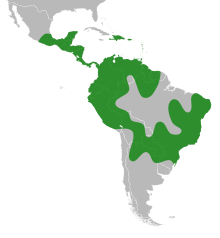Chaetocalyx
Chaetocalyx is a genus of lianas in the legume family, Fabaceae. It belongs to the subfamily Faboideae, and was recently assigned to the informal monophyletic Adesmia clade of the Dalbergieae. Members of this genus are found in Central and South America.[4] Chaetocalyx can be distinguished from most other legumes by its climbing habit, its imparipinnate leaves, and, in most species, by its elongate loments. It can be distinguished from Nissolia, which also has a climbing habit, by the articles of the loments, which are uniform in size in Chaetocalyx, rather than with a terminal, expanded, winglike article as in Nissolia.[3] Unlike most papilionoid legumes, Chaetocalyx species do not form root nodules.[5]
| Chaetocalyx | |
|---|---|
| Scientific classification | |
| Kingdom: | |
| (unranked): | |
| (unranked): | |
| (unranked): | |
| Order: | |
| Family: | |
| Subfamily: | |
| Tribe: | |
| Genus: | Chaetocalyx DC. |
| Type species | |
| Chaetocalyx scandens (L.) Urb. | |
| Species | |
|
See text. | |
 | |
| The distribution of Chaetocalyx.[3] | |
| Synonyms[3] | |
| |
Species
Chaetocalyx comprises the following species:[3][6][4][7][8][9]
- Chaetocalyx acutifolia (Vogel) Benth.
- Chaetocalyx blanchetiana (Benth.) Rudd
- Chaetocalyx bracteosa Rudd
- Chaetocalyx brasiliensis (Vogel) Benth.
- Chaetocalyx chacoensis Vanni
- Chaetocalyx klugii Rudd
- Chaetocalyx latisiliqua Benth.—chupa-chupa
- Chaetocalyx longiflora A. Gray
- Chaetocalyx longiloba Rudd
- Chaetocalyx nigricans Burkart
- Chaetocalyx platycarpa (Harms) Rudd
- Chaetocalyx scandens (L.) Urb.
- var. fissus (Pittier) D. Velázquez[10]
- var. pubescens (DC.) Rudd
- var. scandens (L.) Urb.
- Chaetocalyx subulatus Mackinder
- Chaetocalyx tomentosa (Gardner) Rudd
- Chaetocalyx weberbaueri Harms
References
- Lavin M, Pennington RT, Klitgaard BB, Sprent JI, de Lima HC, Gasson PE (2001). "The dalbergioid legumes (Fabaceae): delimitation of a pantropical monophyletic clade". Am J Bot. 88 (3): 503–33. doi:10.2307/2657116. JSTOR 2657116. PMID 11250829.
- Cardoso D, Pennington RT, de Queiroz LP, Boatwright JS, Van Wyk BE, Wojciechowskie MF, Lavin M (2013). "Reconstructing the deep-branching relationships of the papilionoid legumes". S Afr J Bot. 89: 58–75. doi:10.1016/j.sajb.2013.05.001.
- Rudd VE (1958). "A revision of the genus Chaetocalyx" (PDF). Contributions from the United States National Herbarium. 32 (3): 207–245.
- Mackinder BA (1990). "A new species of Chaetocalyx (Leguminosae-Papilionoideae) from Brazil". Kew Bulletin. 45 (3): 587–589. doi:10.2307/4110525. JSTOR 4110525.
- Diatloff A, Diatloff G (1977). "Chaetocalyx—A non-nodulating papilionaceous legume". Tropical Agriculture (Trinidad). 54: 143–147.
- Rudd VE (1996). "Chaetocalyx longiloba (Fabaceae, Papilionoideae), a new species from Peru". Novon. 6 (1): 119. doi:10.2307/3392223. JSTOR 3392223.
- "ILDIS LegumeWeb entry for Chaetocalyx". International Legume Database & Information Service. Cardiff School of Computer Science & Informatics. Retrieved 5 February 2014.
- USDA; ARS; National Genetic Resources Program. "GRIN species records of Chaetocalyx". Germplasm Resources Information Network—(GRIN) [Online Database]. National Germplasm Resources Laboratory, Beltsville, Maryland. Archived from the original on 24 September 2015. Retrieved 5 February 2014.
- "The Plant List entry for Chaetocalyx". The Plant List. Royal Botanic Gardens, Kew and the Missouri Botanical Garden. 2013. Retrieved 11 January 2017.
- Velázquez D (1990). "Las variedades de Chaetocalyx scandens (Leguminosae - Papilionoideae), en Venezuela". Ernstia. 58–60: 65–69.
| Wikispecies has information related to Chaetocalyx |